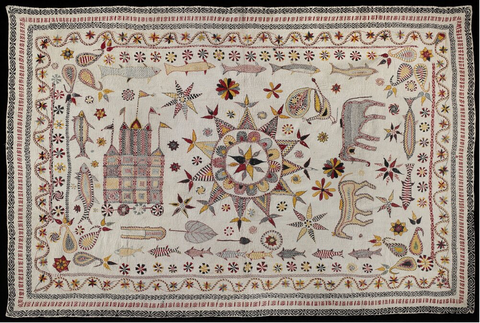Kantha embroidery draws our attention to the resourcefulness of our women in the past, their sustainable way of living, and the socio-cultural life. The rural women reused the pieces of fabric, threads and fashioned them into a new product. Kantha is primarily a traditional embroidery craft from east and west Bengal, and parts of Bihar. The craft has been around us for centuries, being passed on from generation to generation, but there is no known specimen earlier than 1800 CE.
Worn-out dhotis and sarees were used to make square and rectangle pieces of cloth, which were then embroidered with indigo and madder dyed threads. The recycled threads produced subdued shades of blue, red, black and green. These were then used to make quilts, covers and wrappings done in a variety of stitches.
Each kantha has with it numerous personal stories, shared memories, and is part of the heirloom. These are created, shared, repaired and reused from generation to generation. It creates and carries forward the social connections, obligations as well as restrictions.
Kantha embroidery is practised by both Hindu and Muslim women in the region. The Hindu Kayastha women make figurative, elaborate and fine embroidery. It is majorly gifted during the wedding, during the Shashti puja for a new born child, and annaprasana, or when an infant is fed with its first solid food. The Kanthas of Muslim women have less figurative work and more ornate motifs.
In the finest kanthas, the stiches are so cleverly made that that appear exactly same on both the sides. There are many kinds of stiches but the commonest and the most typical is small darning stitch which produces a dotted effect worked through all layers of the fabric, forming a pattern on both the sides. Other stitches are satin stitch, loop stitch, stem stitch among others.
Applique work is also quite common on kantha and is of two kinds –
- The motif is cut out of red cloth and stitched on a white background. This is done on large articles life flags or canopies.
- The coloured cloth is cut into narrow stripes and these designs are sewn like braid around the outlines of the designs.
Kantha usually has a central lotus medallion and four trees or vegetable motifs at the four corners of the spread. The remaining space is accommodated with episodes from legends, scenes from daily life, birds, animals, trees, even railway trains and motor cars.

Mandala and Kalasha are two ritual designs embroidered by women on occasion of different festivals. There are different kinds of Kanthas which are made for different purposes.
- Lep Kantha – It is an embroidered wrap for body, to be used during winters.
- Oar Kantha – It is a rectangular pillow cover
- Sujni Kantha – The word sujni is derived from the word ‘sojan’ which means sewn cloth. It is an embroidered ceremonial wrap. It can also be used as a sitting mat to honour guests during ceremonial occasions such as weddings. These are also used as bed covers. These are generally rectangular in shape.
- Baytan Kantha – It is used as a wrap for books and valuables. These are generally square in shape. There is a wide border with several rows of human and animal designs. The centre has an elaborate lotus.
- Durjani Kantha – It consists of square wraps which are stitched together to form a wallet. It has an embroidered border and elaborate lotus in the middle. It can be used to hold rosary beads, betel nuts, money, etc.
- Arshilata Kantha – It literally translates to mirror Kantha, but its utility is to wrap and cover. These wraps are used for mirrors and combs, and are narrower and rectangular. It has a wide border on all four sides.
- Rumal Kantha – Like its name suggests, it is used as a handkerchief. Its centre consists of a lotus with other traditional motifs around it.

Kanthas are not just used to prepare quilts, covers and wrappings. They also showcase and narrate legends and tales of heroism. There have been numerous references to Kantha like work in the Rigveda, Upanishads and classical Buddhist texts. Some Kushana sculptures also show embroidered patch cloth whose motifs resemble to that of Kantha.
Today, the modifications have made Kantha commercialised along with its traditional uses. Though it is still a stronghold of women, it is also commercially practised by men. It is important for us to continue to empower the artists to ensure their livelihoods and the tradition of kantha.
~ Written by, Misha Jaswal
Bibliography
- Kantha – Journal of Indian society of Oriental Art by Stella Kramrisch
- Unknown India by Stella Kramrisch
- Embroidered textiles: a world guide to traditional patterns by S. Paine
- The art of Kantha Embroidery by N. Zaman
- The art of Kantha – modern review by G.S. Dutta






















